Brighton and Hove Albion Women are one of those teams that can have rises and falls in the same season. Currently, they are in good form, with their loss last weekend their first in five games. Manager Hope Powell, who took charge in 2017, has made her squad unpredictable, meaning they are always fun to watch. One of her signings last summer was Netherlands international Inessa Kaagman, who joined from Everton Women on a free transfer. Capable of playing as a midfielder or a forward, she has given them a lot of options on the pitch. This tactical analysis will look at her key characteristics on the field, seeing what she brings to Brighton’s tactics, and we will also look at her statistics from this season, picking out her strengths and areas where she can improve further.
Before we go any further, let’s first look at her heatmap from this season.
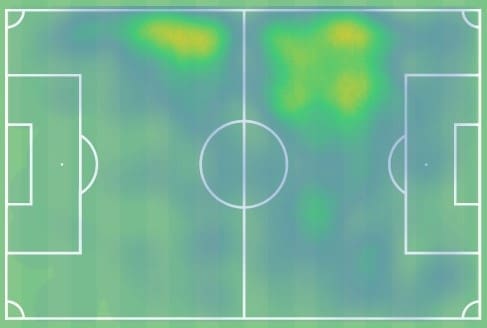
Here, we see how she mainly occupies spaces on the left side of the pitch. However, the key point to take from this is that she doesn’t just play in the final third; she is very much a player who can move around, ensuring her team have plenty of options in spaces. This gives us several ideas that we will now break down in the following sections.
Positioning and awareness
Inessa Kaagman’s positioning and awareness of her surroundings is key to her team’s play. When she receives the ball, Brighton and Hove Albion Women’s forward players position themselves in good areas, offering her passing options, knowing she will always be aware of where they are.
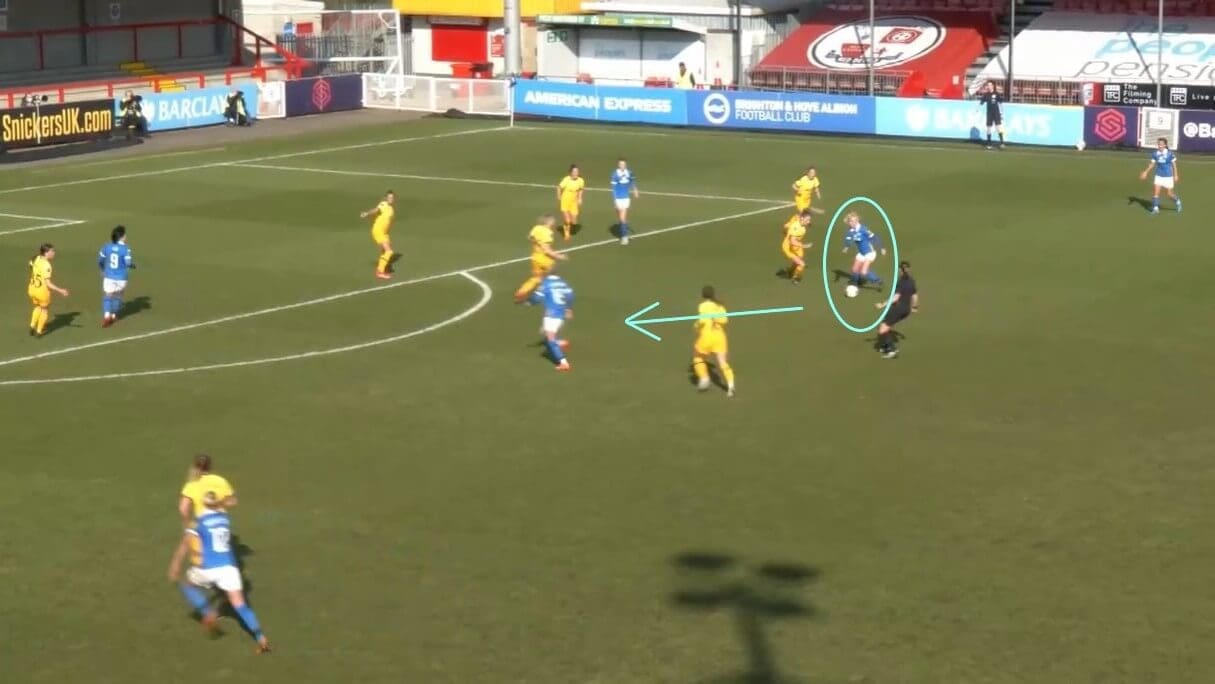
Here, we see just this. Kaagman has the ball just outside the area, having found a small space amongst the opposing defenders to play in. She initially went towards the far side of the pitch, before turning and facing towards the nearside. By doing so, she pulls the defenders out of position, creating a gap, and we can see how she now has space to pass into as a result.
As mentioned, her teammates get into spaces around her, giving her a mix of short and long passing options, because they know that she will make the pass forwards when she gets the chance. Therefore, Kaagman’s ability to position herself in these spaces creates a pivot effect, with Kaagman the central point of their attacks, linking up different players, and helping to move the ball into dangerous areas.
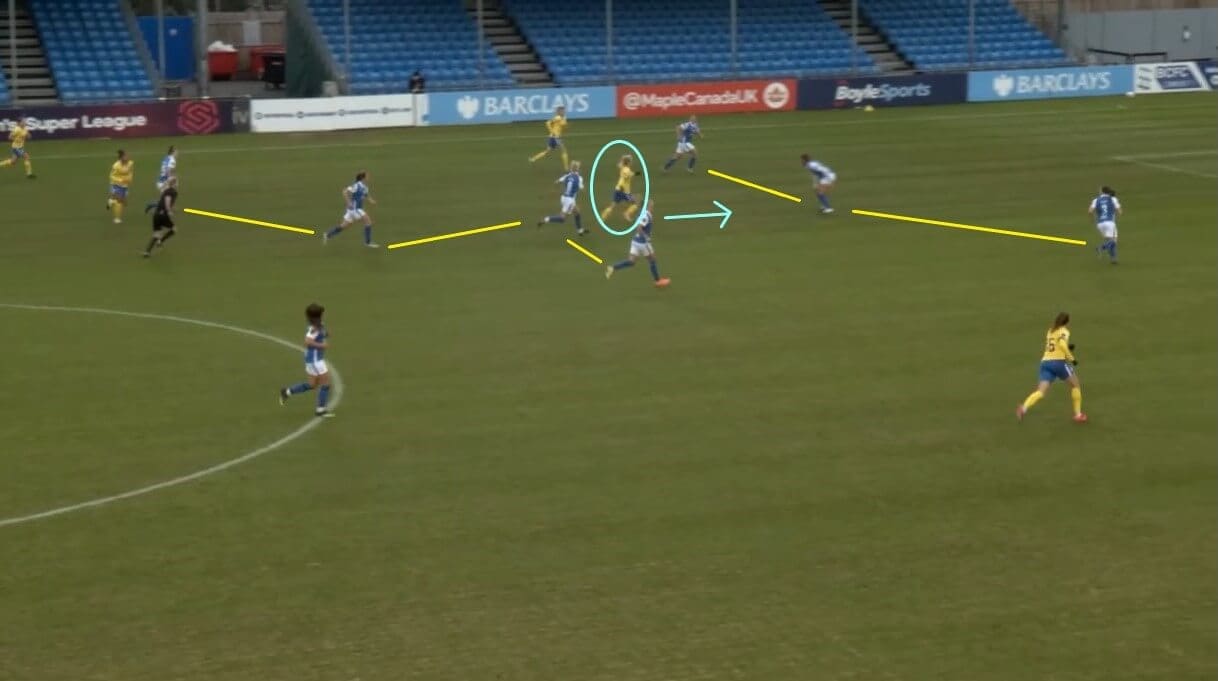
This image shows another example of Kaagman finding and positioning herself in space. Birmingham City Women have played with a very defensive setup this season, with manager Carla Ward looking to make them harder to beat. This means that they have often had two lines of players behind the ball, stopping opposing attackers accessing the space behind them.
However, here, Kaagman has got herself in between Birmingham’s lines, preventing them all getting back behind the ball. This decreases the number of defenders Brighton have to get past, and so we can again see how Kaagman’s positioning and spatial awareness is key in her side breaking down opposing defences.
Finally with this image, we can see again how Kaagman’s teammates have got into positions on either side of her, offering her passing options away from the Birmingham defenders. This is what Kaagman’s spatial awareness has brought to Brighton, and how it has helped them build their attacks.
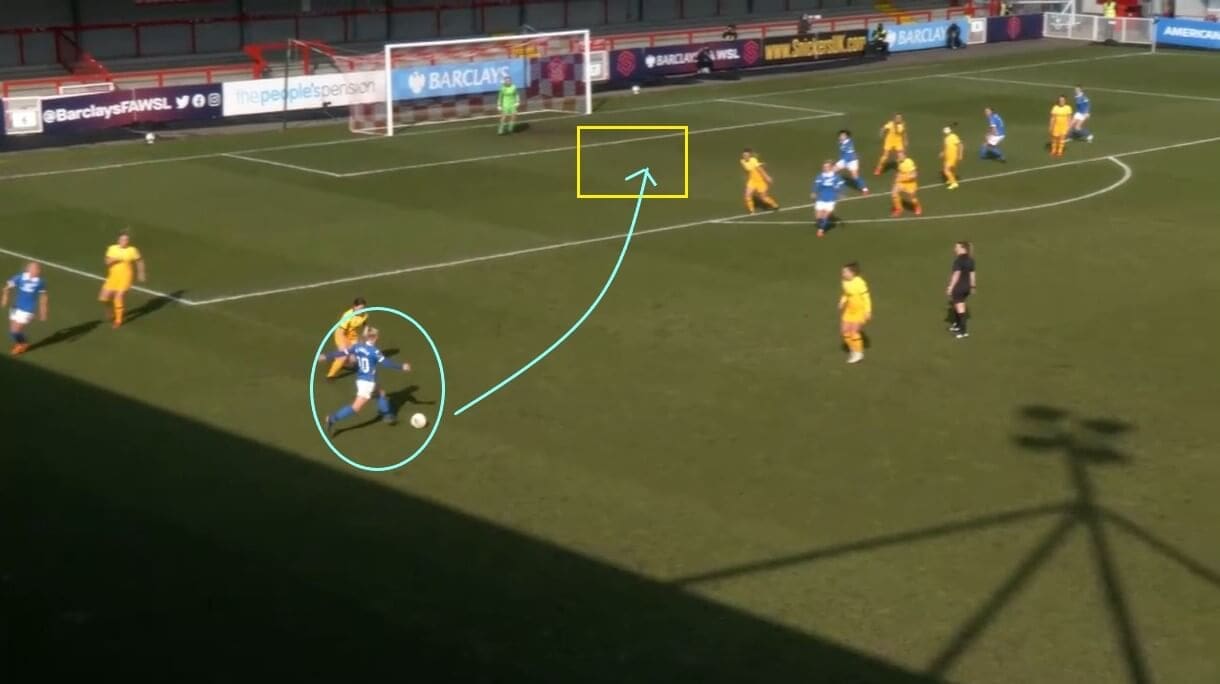
However, it is not just centrally where Kaagman’s positioning helps her team. In this image, we see how she has taken up a wider position instead. The opposing defenders have moved into the middle, looking to mark the other Brighton attackers, and this gives Kaagman two options. Firstly, she can play the ball into the area ahead of her teammates, either aerially or along the ground, or, secondly, she can have a shot at goal herself. She opts for the first option here, aiming for the target area inside the box, as shown by the yellow square, and one of her teammates attempts to meet it.
The thing to take from this image is that it doesn’t matter where Kaagman is on the pitch, she always knows what is around her, where the space is, and where she can create an opportunity for her teammates. This is another thing that she has brought to the team this season.
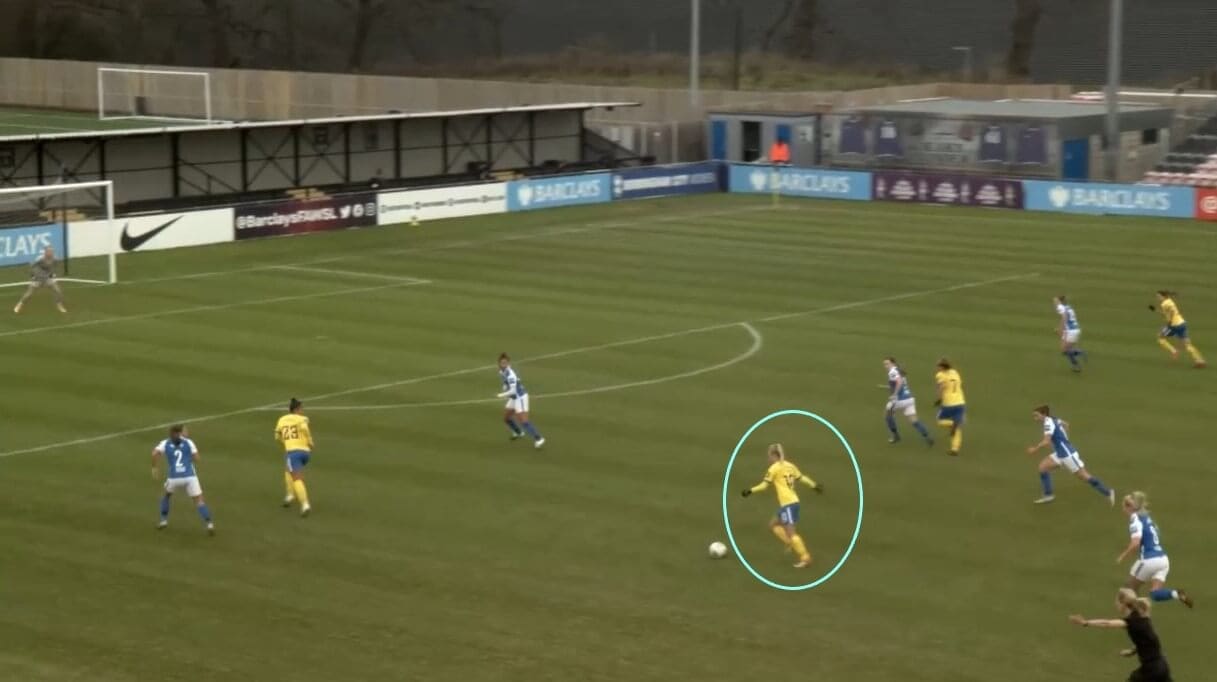
She doesn’t only look to pass when in good positions. Here, against Birmingham, she has got into an area where she could pass the ball forward, but instead decides to have a shot at goal on her own. This again demonstrates her positional abilities, and, having looked at what is around her, knows there is no easy pass here, highlighting her awareness too.
What helps to give Kaagman the space is her teammates taking the Birmingham defenders away from her, increasing the size of the pitch. It is likely that this was because they were giving the Dutch international passing options around the box, as we have already seen them do, but it also helps Kaagman to take the shot at goal.
Creating options
We have looked at how Inessa Kaagman positions herself well, but we will now see how that creates options for her teammates, particularly when moving the ball into dangerous areas of the pitch.
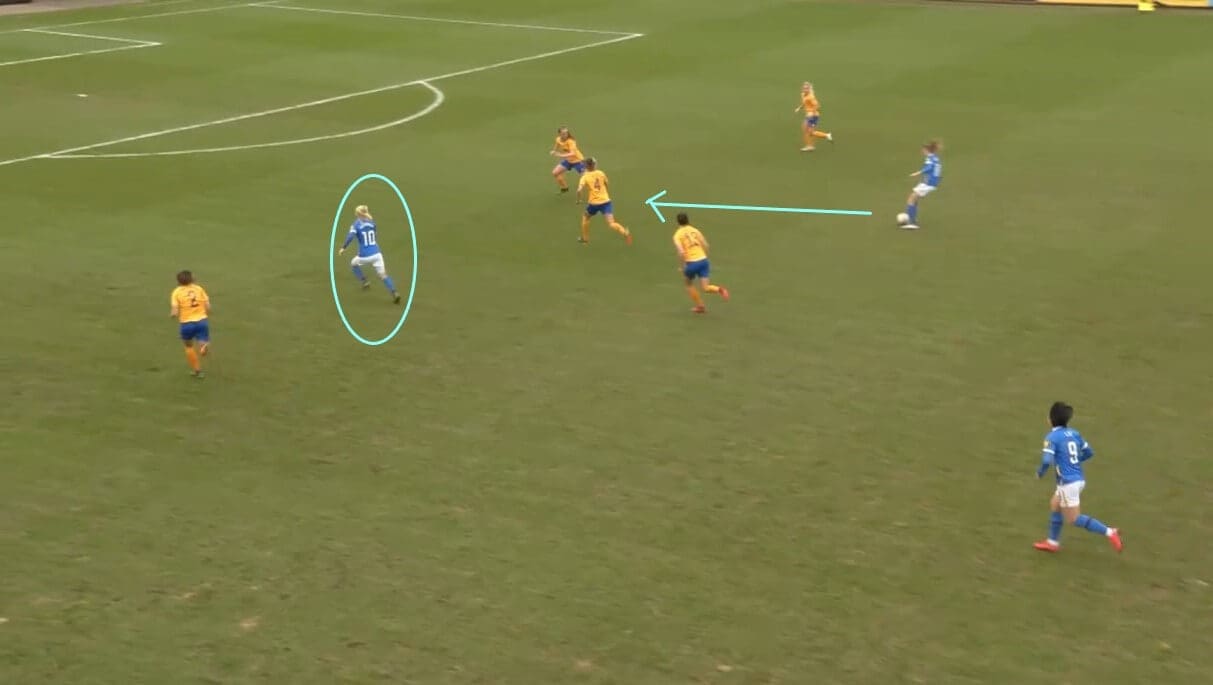
One of her key characteristics is pace, and this helps her to get into areas before defenders can close them or her down. Here, we see how she is the furthest player forward, looking to get behind the Everton defence. We can see how she has found the gap between the defenders as well, making it harder for Everton to block her run off when she does move forward. The pass here doesn’t come off, as Everton manage to intercept it before it reaches Kaagman, but the intention is still good.
Tactically, this is how she comes into play as a forward, and gives Brighton a similar style of play to Arsenal Women, with Vivianne Miedema moving out to the wings at times, whilst other players like Caitlin Foord move inside to take her position centrally. Similarly, with Kaagman filling the space left open here, Brighton always have a target player in the final third of the pitch, ensuring that space is never left available for opponents to occupy.
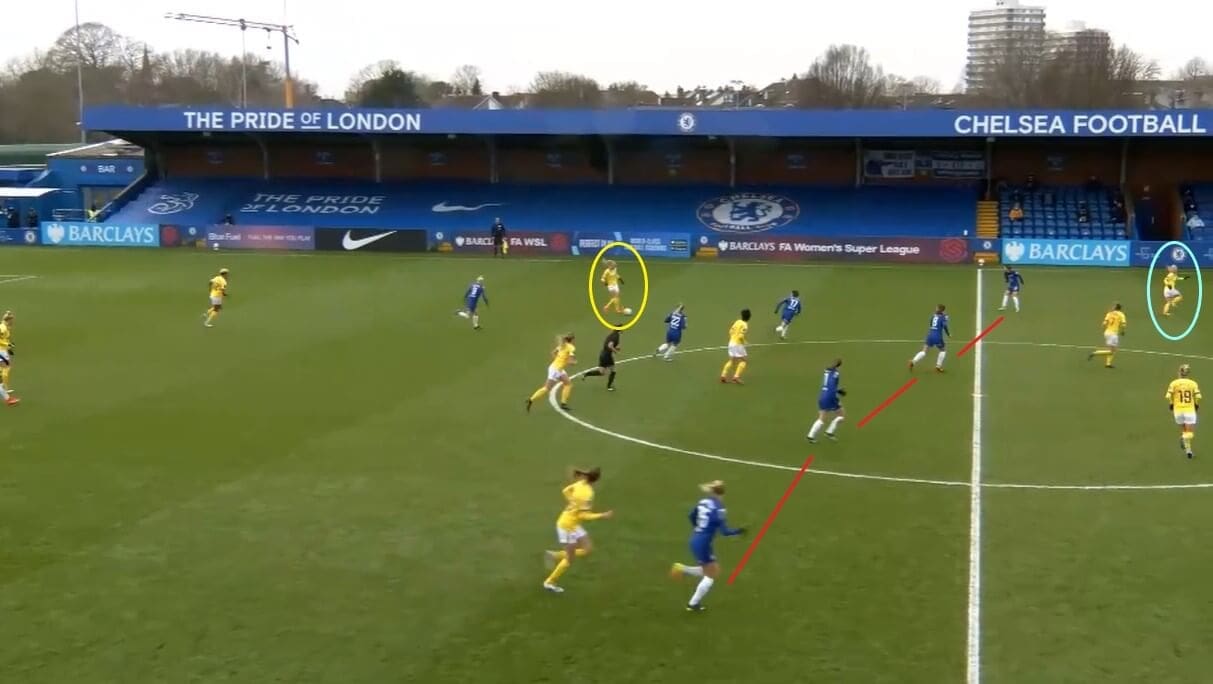
This image shows a similar situation, but this time, against Chelsea Women, Kaagman, in the blue circle, has got behind the Chelsea players, rather than alongside them. Her teammate with the ball is marked by the yellow circle, and so Kaagman’s run gives her the long passing option if she needs or wants it.
Chelsea like to push their players as high up the pitch as possible, so Brighton’s clever tactics here of keeping their quicker players behind them means Chelsea have to constantly be aware of the danger. Kaagman’s role is key, because, whenever Brighton do win the ball, she becomes their target player, allowing them to play the quick counter-attacking pass up the pitch before Chelsea can get back to block her off.
When she signed for the team last summer, Hope Powell said that Kaagman would bring energy to the midfield and also add goals, which is something they had been missing. When we consider situations like this one, we see just how Kaagman will bring those qualities, with pace enabling her to be the target player, and, by operating in the space behind opposing defences, she will help to provide the end product too.
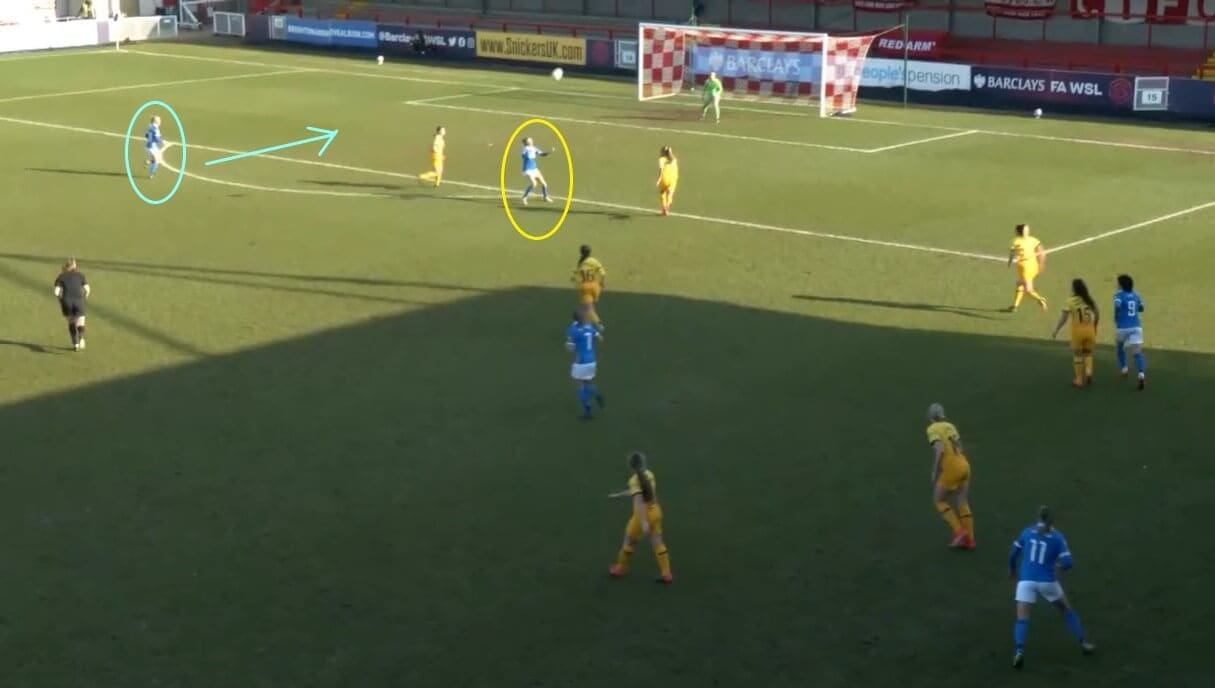
This image shows one time she did score, in Brighton’s recent home game against Tottenham Hotspur Women. Here, Brighton have looked to move the ball towards the edge of the box, with the cross coming in from Finland midfielder Nora Heroum, with forward Ellie Brazil, in the yellow circle, waiting to receive the ball. However, whether intentional or not, the ball is a little too powerful for her, and she heads it behind to where Kaagman is.
The Dutch international’s positioning here is worth discussing, because it shows her ability to know where the ball is going, and therefore where to position herself to receive it and cause problems for the opponents. Here, her run into the box gave Heroum the second passing option, and, with Tottenham’s defenders moving to close Brazil down as she receives the ball, Brighton would not have scored this chance if Kaagman hadn’t made the movement into the space behind her. Therefore, again, we see how she gives her side options around the pitch.
Versatility
The final aspect of her play to discuss is her versatility. Normally, this means playing in different roles in the same area of the pitch, but Kaagman, as mentioned, can play as a midfielder or a forward. Therefore, she can fill several roles around the pitch for Brighton and Hove Albion Women, which is why she has become such a key part of their tactics this season.
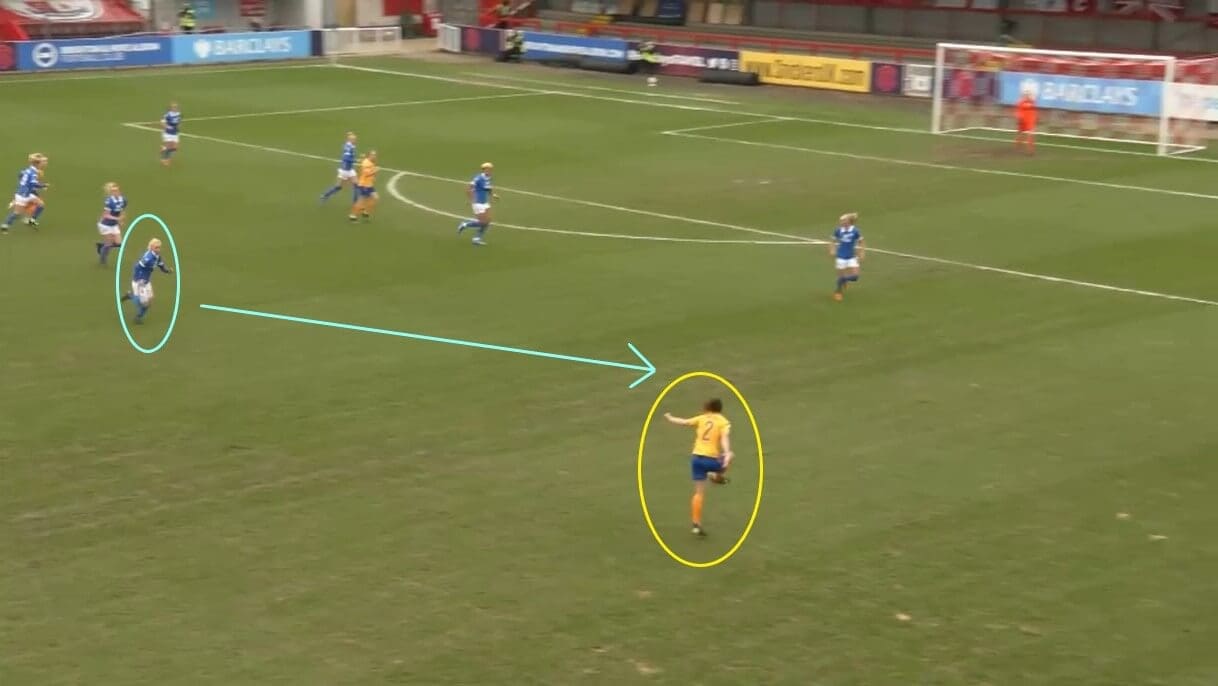
Here, Everton are attacking the Brighton third, with Norway right-back Ingrid Moe Wold in possession, in the yellow circle. Wold is in plenty of open space, and so can pick where to play the ball to, with a central attacker positioned on the edge of the box. However, Kaagman has seen this danger, and comes across at speed to close it down, successfully making the block. Therefore, her pace, which we have already looked at in attacking situations, allows her to close opponents down when they are in dangerous areas.
Being able to adapt and use her qualities in defensive situations too is one way her versatility is demonstrated, because she can play in a deeper position, helping to close opponents down when they have the ball in spaces like this. This comes in useful when Brighton are facing a side with attack-minded tactics, such as Manchester United Women or Manchester City Women, as it will stop them playing their usual game.
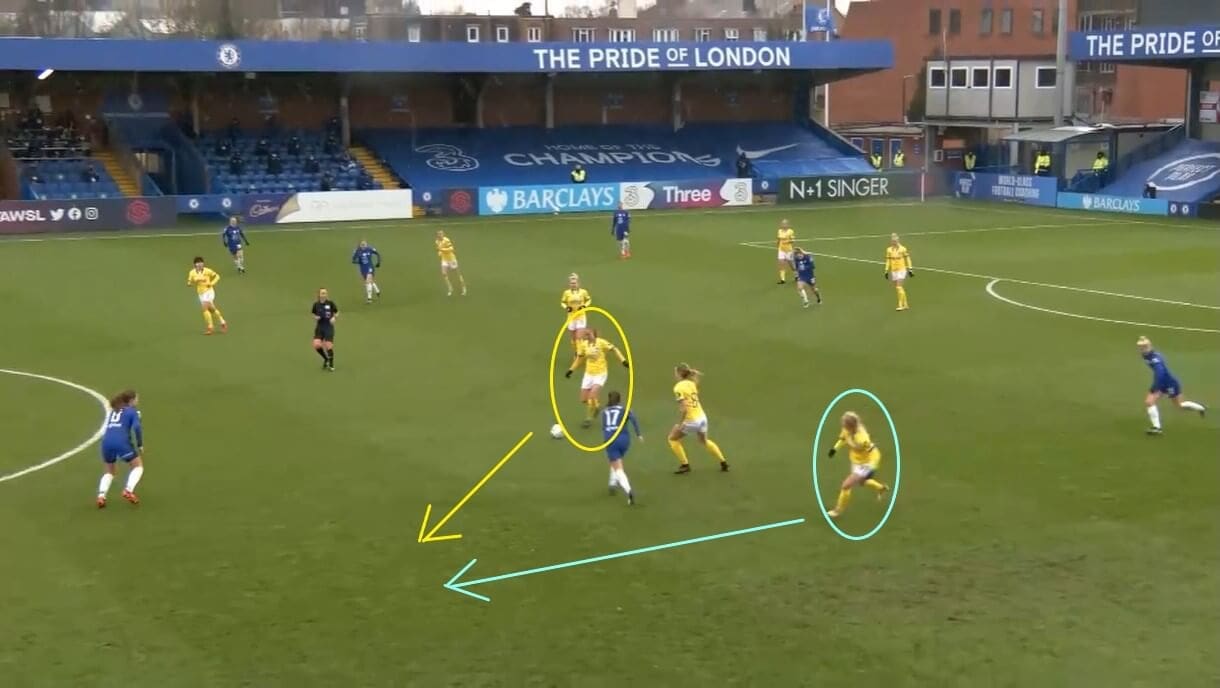
Her pace also comes into play when Brighton are in transition from defence to attack. Here, they have taken the ball back in their own half against Chelsea, but don’t have any options up the pitch to pass to. Kaagman, in the blue circle, is in a wider position, and looks to make the run forward, meeting the pass when it comes through the gap between Chelsea midfielders Jessie Fleming and Melanie Leupolz, as indicated by the yellow arrow. Even when their defence doesn’t get forward, Chelsea still push their midfielders up the pitch, and so Kaagman’s run again allows Brighton to get behind them and isolate the defence, before the rest of the Chelsea players can get back.
Therefore, again, we see how Kaagman’s pace, but also her spatial awareness here, allows her to play a key role in her team’s tactics, this time when moving the ball from the back to the front of the pitch.
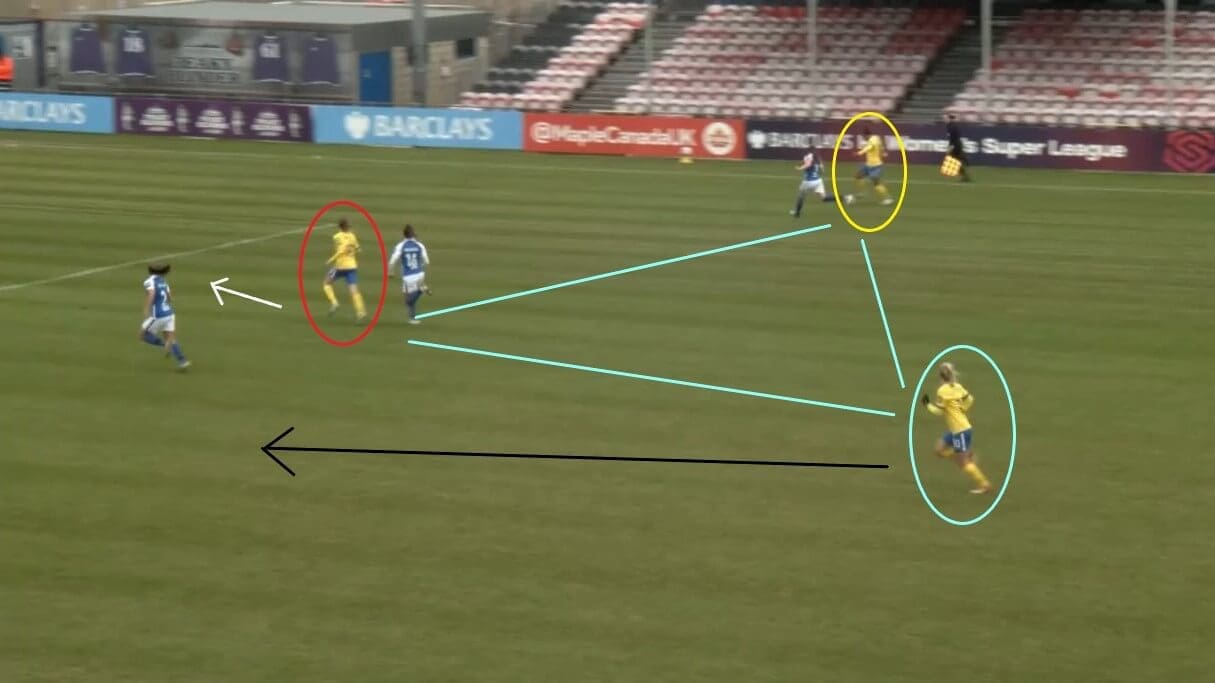
We have already looked at Kaagman’s role in attack, but mainly on her own. This time, we can see how she alters the direction she runs in, depending on where her teammates are positioned. This creates formational structures like the one we see here, where three players are now working together to create a 3-v-3 in Birmingham’s half. Striker Rianna Jarrett is on the wing, looking to move the ball into the middle. Her main option ahead of the defence is marked by the red circle, and this player is moving through a gap ahead of her, as shown by the white arrow.
Kaagman sees this, and looks to run behind the Birmingham defenders, where they can’t see her. This movement, indicated by the black arrow, gives Brighton another option in the box, increasing their attacking presence and ensuring that the attack doesn’t break down as easily as it might have done.
This section has provided us with several different ways that Inessa Kaagman features in Brighton’s tactics, in defence, midfield and attack, and this is why her versatility and ability to fill different roles is critical to Brighton’s success this season.
Data analysis
We have identified three different aspects of Inessa Kaagman’s play that help her team, but we will now look more specifically at her statistics, analysing what her strengths and areas for improvement are.
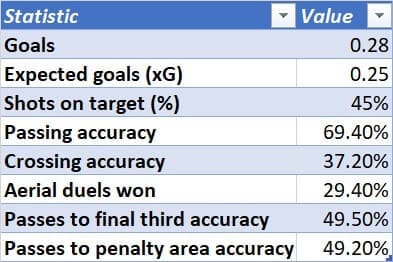
Given that Kaagman was brought in to help Brighton and Hove Albion Women score more goals, it is perhaps surprising that she has such low goals and expected goals (xG) values, in 0.28 and 0.25 respectively. However, this is because she does more than sitting in the final third and scoring, as highlighted in this scout report. What is important is that she is exceeding her xG, as that shows that she is producing on the field what she was brought in to do.
Her passing accuracy of 69.4% is her highest statistic, reflecting her ability to receive the ball and transfer it onwards for her teammates to get on the end of. Likewise, her passes to the final third and penalty area values (49.5% and 49.2% respectively) are also very respectable, as that is just under one in every two passes that goes where intended.
One area she can improve on is her crossing accuracy, which only comes in at 37.2%. This is still a good value, but we have seen how she often features in a wide forward role. Therefore, if she can improve on this, Brighton might be able to create more chances, and potentially score more goals. They currently sit sixth in the table, having scored just 15 goals in their 18 games, so, although this is an improvement on their 11 goals in 16 games last season, increasing the accuracy of crosses going into the box would help them to score more, meaning they might be able to challenge the teams above them, and potentially cause more problems in individual games too.
Conclusion
In conclusion, we have seen in this analysis how Netherlands international Inessa Kaagman is a key player in Brighton and Hove Albion Women’s tactics. We have looked in detail at her positioning and awareness, how she creates options for others, and her versatility and ability to fill numerous roles on the pitch. We have also looked at her strengths and areas to work on, which will help not just her but the whole team to improve. However, there is no doubting that Kaagman’s arrival has been a positive, giving Brighton a different threat this season, and will potentially help them improve on their ninth-placed finish in the WSL in 2019/2020.




Comments